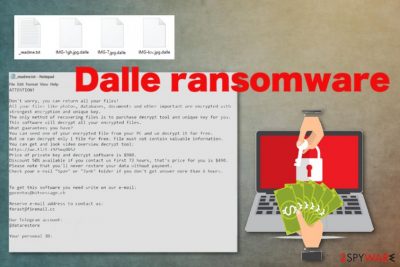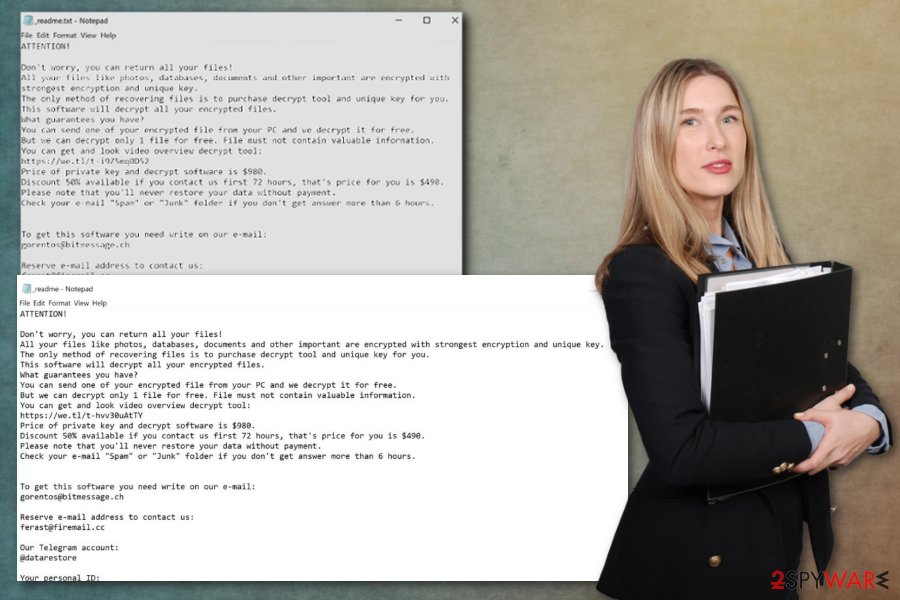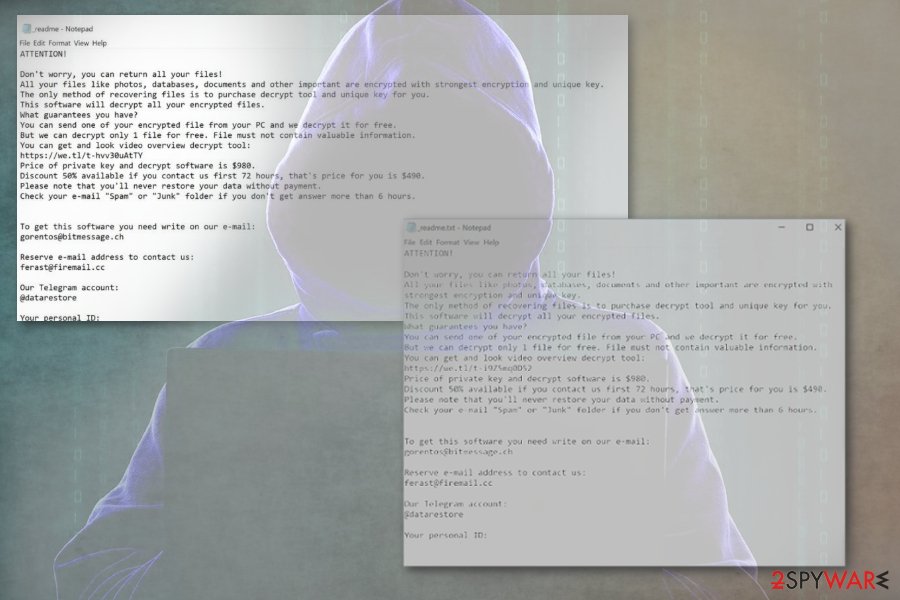Dalle ransomware (Removal Guide) - Free Instructions
Dalle virus Removal Guide
What is Dalle ransomware?
Dalle ransomware is the cryptovirus that belongs to a huge crypto malware family with more than 100 versions

Dalle ransomware is the cryptovirus that marks encrypted data using .dalle appendix and demands to pay up for the alleged decryption key. This is not a very altered version of the well-known Djvu ransomware that spiked in Spring 2019 with a new version after version. Many features remain the same for all these variants, but developers are quick to create new threats and release them to the wild since malware researchers like Michael Gillespie update the STOP virus decryptor and make it capable of decrypting all the new versions. At the time of writing, the particular version was not yet added to the decryption tool, so wait for the more recent update and remove the ransomware instead.
This crypto malware is the threat that as well as other members in the family focuses on file encryption. Dalle ransomware virus gets the name from the file marker it adds for every encoded file – .dalle. An additional feature that unifies all the versions of this family – the discount offer and alleged test decryption. However, as real and legitimate, it may seem this is the method to fake trust and make people more eager to pay or send files for the criminals. Do not settle and stay away from these hackers.
| Name | Dalle ransomware |
|---|---|
| Type | Cryptovirus[1] |
| Family | Djvu/STOP |
| File marker | .dalle |
| Ransom note | _readme.txt |
| Ransom amount | $980/$490 |
| Contact information | gorentos@bitmessage.ch, ferast@firemail.cc |
| Distribution | Infected file attachments from spam emails, malicious updates, fake software |
| Elimination | Get FortectIntego for the proper Dalle ransomware removal and virus damage elimination |
Since Dalle ransomware is a cryptovirus, it focuses on file encoding first and additional alterations on the system. The virus is designed to make various changes in the settings so that the threat can run ints processes freely. These alterations even include installing programs, adding files, disabling functions or AV tools and deleting data like Shadow Volume Copies.
The latter ensures that data recovery is difficult for the victim, and the only solution left is to pay up for the criminals behind this Dalle ransomware virus. Also, this virus may include secondary payloads or malicious scripts and load malware on the machine like trojans, info-stealers, worms.[2]
The encryption process begins when Dalle ransomware scans the system to see if the PC was encrypted before and locates files for the locking. Data that gets encrypted includes:
- photos,
- videos,
- documents,
- archives,
- audio files,
- music,
- databases.
Once Dalle ransomware changes the original code of the file, data becomes useless and unopenable, locked. Immediately after the encryption, files get .dalle extension. This is how you can identify the affected data from untouched files. The virus doesn't encrypt system files but may alter them, as we mentioned. Many parts of the machine get damaged and changed by this threat, especially when you give time on the PC for the malware.

Once Dalle ransomware is done with encryption, the ransom note in the file _readme.txt is delivered on the desktop, and in various folders where encoded data is. This message details the encryption, the possible damage to your files and demands to pay $980 for the decryption key.
As any other cybercriminals, Dalle ransomware creators want to get the ransom paid in cryptocurrency and offers a discount of 50% if the victim writes them via gorentos@bitmessage.ch, ferast@firemail.cc or Telegram in less than 72 hours. Try to avoid any contact with extortionists and remove the threat once you receive the following or a similar message:
ATTENTION!
Don't worry, you can return all your files!
All your files like photos, databases, documents and other important are encrypted with strongest encryption and unique key.
The only method of recovering files is to purchase decrypt tool and unique key for you.
This software will decrypt all your encrypted files.
What guarantees you have?
You can send one of your encrypted file from your PC and we decrypt it for free.
But we can decrypt only 1 file for free. File must not contain valuable information.
You can get and look video overview decrypt tool:
hxxps://we.tl/t-i9Z5mq0D52
Price of private key and decrypt software is $980.
Discount 50% available if you contact us first 72 hours, that's price for you is $490.
Please note that you'll never restore your data without payment.
Check your e-mail “Spam” or “Junk” folder if you don't get answer more than 6 hours.To get this software you need write on our e-mail:
gorentos@bitmessage.chReserve e-mail address to contact us:
ferast@firemail.ccOur Telegram account:
@datarestoreYour personal ID:
Dalle ransomware creators are criminals, and all they care about is making a profit from victims. You should note that when the threat gets enough time on the machine, it can install other malware that is designed to steal your personal information, credentials, and infect or damage the device even more.
Remove Dalle ransomware with tools that can detect the threat as malicious and remove all the parts of this virus.[3] You need to get a reliable anti-malware program and run the check on the machine for any corrupted files, malware, and viruses like this crypto malware.

Install FortectIntego for the automatic Dalle ransomware removal and follow closely what malware the program finds. This tool scans the machine entirely and indicates possible intruders, errors, and vulnerabilities. You can easily remove the malware and fix virus damage with one tool.
When it comes to Dalle ransomware decryption and file recovery, we as other experts[4] recommend restoring files from a backup or using data recovery software after the virus elimination. However, you can wait for the official update on STOP decrypter and store encoded files on the external drive. You still need to terminate the ransomware with all the programs and associated files before anything else.
Common ways of ransomware distribution
The most known method for malicious script delivery is the spam email campaigns with infected attachments. Phishing emails get delivered to the user, and when the email itself looks legitimate enough, the file gets opened without even questioning the possible danger.
Unfortunately, documents, executables and other types of data get attached to the email, and once the file is opened and downloaded on the machine, direct ransomware or a virus payload gets loaded on the system. From there, your device gets infected and altered behind your back.
You can avoid such cyber infections if you pay close attention to the emails you receive and files you download and open on the computer. Such malicious files can get installed via fake software updates or cracks, so keep the machine safe by choosing reliable sources for your applications.
Dalle files virus termination requires proper tools designed for fighting ransomware
When people get attacked by such crypto malware like Dalle ransomware virus, the first thing they encounter is the questionable processes and slowness of the machine. Ransomware adds various files and programs that run on the PC and affects the performance significantly.
Remember that threat also disables security functions, AV programs, other applications, and adds registry keys to make sure all the malware parts run smoothly. You need to remove Dalle ransomware altogether alongside all the files and programs, which is difficult to achieve manually.
Dalle ransomware removal gives the best results when you employ FortectIntego, SpyHunter 5Combo Cleaner, or Malwarebytes and run a thorough system scan. When the anti-malware tool checks the computer, it can detect and remove all problems, malware, and fix virus damage. Clean the machine before any data recovery.
Getting rid of Dalle virus. Follow these steps
Manual removal using Safe Mode
Reboto the machine in Safe Mode with Networking for the best Dalle ransomware removal results
Important! →
Manual removal guide might be too complicated for regular computer users. It requires advanced IT knowledge to be performed correctly (if vital system files are removed or damaged, it might result in full Windows compromise), and it also might take hours to complete. Therefore, we highly advise using the automatic method provided above instead.
Step 1. Access Safe Mode with Networking
Manual malware removal should be best performed in the Safe Mode environment.
Windows 7 / Vista / XP
- Click Start > Shutdown > Restart > OK.
- When your computer becomes active, start pressing F8 button (if that does not work, try F2, F12, Del, etc. – it all depends on your motherboard model) multiple times until you see the Advanced Boot Options window.
- Select Safe Mode with Networking from the list.

Windows 10 / Windows 8
- Right-click on Start button and select Settings.

- Scroll down to pick Update & Security.

- On the left side of the window, pick Recovery.
- Now scroll down to find Advanced Startup section.
- Click Restart now.

- Select Troubleshoot.

- Go to Advanced options.

- Select Startup Settings.

- Press Restart.
- Now press 5 or click 5) Enable Safe Mode with Networking.

Step 2. Shut down suspicious processes
Windows Task Manager is a useful tool that shows all the processes running in the background. If malware is running a process, you need to shut it down:
- Press Ctrl + Shift + Esc on your keyboard to open Windows Task Manager.
- Click on More details.

- Scroll down to Background processes section, and look for anything suspicious.
- Right-click and select Open file location.

- Go back to the process, right-click and pick End Task.

- Delete the contents of the malicious folder.
Step 3. Check program Startup
- Press Ctrl + Shift + Esc on your keyboard to open Windows Task Manager.
- Go to Startup tab.
- Right-click on the suspicious program and pick Disable.

Step 4. Delete virus files
Malware-related files can be found in various places within your computer. Here are instructions that could help you find them:
- Type in Disk Cleanup in Windows search and press Enter.

- Select the drive you want to clean (C: is your main drive by default and is likely to be the one that has malicious files in).
- Scroll through the Files to delete list and select the following:
Temporary Internet Files
Downloads
Recycle Bin
Temporary files - Pick Clean up system files.

- You can also look for other malicious files hidden in the following folders (type these entries in Windows Search and press Enter):
%AppData%
%LocalAppData%
%ProgramData%
%WinDir%
After you are finished, reboot the PC in normal mode.
Remove Dalle using System Restore
Try System Restore for this malware and recover machine in a previous state
-
Step 1: Reboot your computer to Safe Mode with Command Prompt
Windows 7 / Vista / XP- Click Start → Shutdown → Restart → OK.
- When your computer becomes active, start pressing F8 multiple times until you see the Advanced Boot Options window.
-
Select Command Prompt from the list

Windows 10 / Windows 8- Press the Power button at the Windows login screen. Now press and hold Shift, which is on your keyboard, and click Restart..
- Now select Troubleshoot → Advanced options → Startup Settings and finally press Restart.
-
Once your computer becomes active, select Enable Safe Mode with Command Prompt in Startup Settings window.

-
Step 2: Restore your system files and settings
-
Once the Command Prompt window shows up, enter cd restore and click Enter.

-
Now type rstrui.exe and press Enter again..

-
When a new window shows up, click Next and select your restore point that is prior the infiltration of Dalle. After doing that, click Next.


-
Now click Yes to start system restore.

-
Once the Command Prompt window shows up, enter cd restore and click Enter.
Bonus: Recover your data
Guide which is presented above is supposed to help you remove Dalle from your computer. To recover your encrypted files, we recommend using a detailed guide prepared by 2-spyware.com security experts.If your files are encrypted by Dalle, you can use several methods to restore them:
Data Recovery Pro is the tool used for file restoring instead of data backups
Rely on Data Recovery Pro for encrypted file restoring and when you need to recover accidentally deleted files
- Download Data Recovery Pro;
- Follow the steps of Data Recovery Setup and install the program on your computer;
- Launch it and scan your computer for files encrypted by Dalle ransomware;
- Restore them.
Windows Previous Versions is the alternate method for data restoring after Dalle ransomware attack
When you enabled System Restore, Windows Previous Versions can be helpful for data recovery
- Find an encrypted file you need to restore and right-click on it;
- Select “Properties” and go to “Previous versions” tab;
- Here, check each of available copies of the file in “Folder versions”. You should select the version you want to recover and click “Restore”.
ShadowExplorer is the method used to recover data
When Dalle ransomware leaves Shadow Volume Copies untouched, you can restore files with ShadoExplorer
- Download Shadow Explorer (http://shadowexplorer.com/);
- Follow a Shadow Explorer Setup Wizard and install this application on your computer;
- Launch the program and go through the drop down menu on the top left corner to select the disk of your encrypted data. Check what folders are there;
- Right-click on the folder you want to restore and select “Export”. You can also select where you want it to be stored.
Keep an eye for STOP virus decrypter updates
Finally, you should always think about the protection of crypto-ransomwares. In order to protect your computer from Dalle and other ransomwares, use a reputable anti-spyware, such as FortectIntego, SpyHunter 5Combo Cleaner or Malwarebytes
How to prevent from getting ransomware
Do not let government spy on you
The government has many issues in regards to tracking users' data and spying on citizens, so you should take this into consideration and learn more about shady information gathering practices. Avoid any unwanted government tracking or spying by going totally anonymous on the internet.
You can choose a different location when you go online and access any material you want without particular content restrictions. You can easily enjoy internet connection without any risks of being hacked by using Private Internet Access VPN.
Control the information that can be accessed by government any other unwanted party and surf online without being spied on. Even if you are not involved in illegal activities or trust your selection of services, platforms, be suspicious for your own security and take precautionary measures by using the VPN service.
Backup files for the later use, in case of the malware attack
Computer users can suffer from data losses due to cyber infections or their own faulty doings. Ransomware can encrypt and hold files hostage, while unforeseen power cuts might cause a loss of important documents. If you have proper up-to-date backups, you can easily recover after such an incident and get back to work. It is also equally important to update backups on a regular basis so that the newest information remains intact – you can set this process to be performed automatically.
When you have the previous version of every important document or project you can avoid frustration and breakdowns. It comes in handy when malware strikes out of nowhere. Use Data Recovery Pro for the data restoration process.
- ^ Cryptovirology. Wikipedia. The free encyclopedia.
- ^ Emotet: the malware behind 45% of malicious URLs. Pandasecurity. Antivirus software developers' blog.
- ^ Malware detection rate. Virustotal. Online malware scanner.
- ^ Virusai. Virusai. Spyware related news.





















